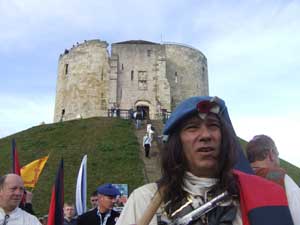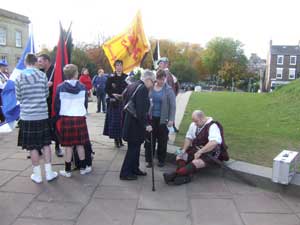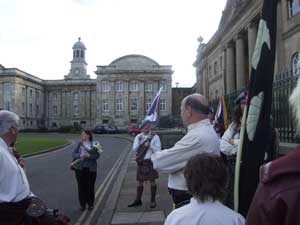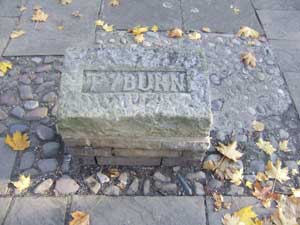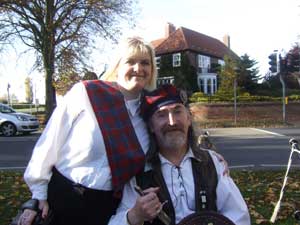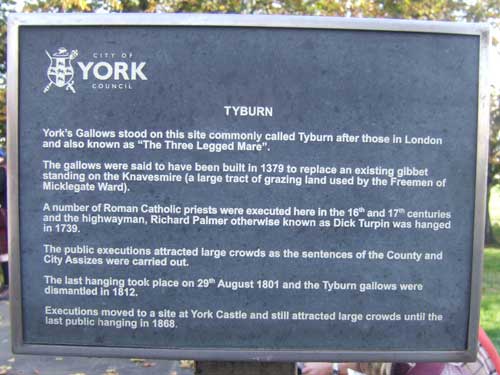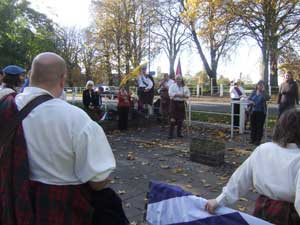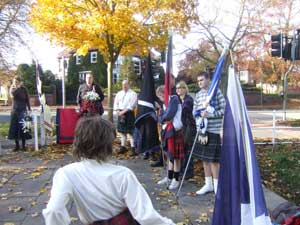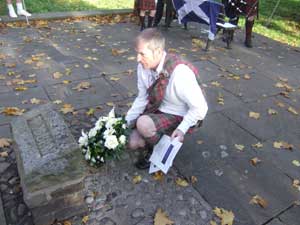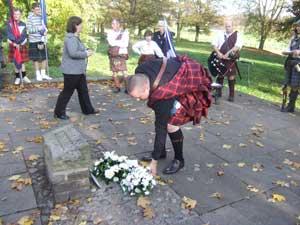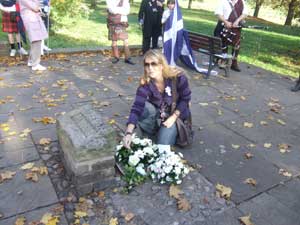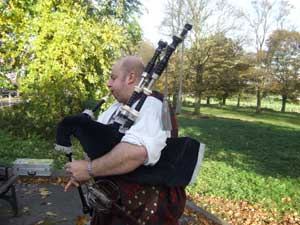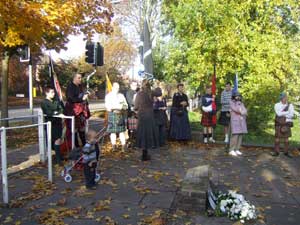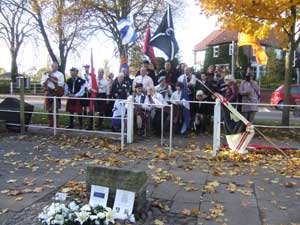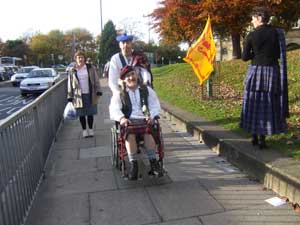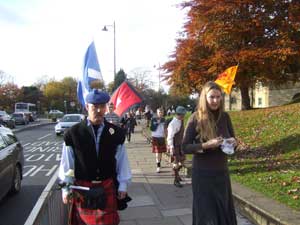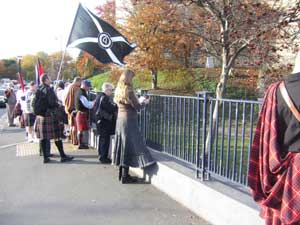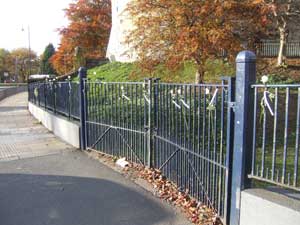Fine autumn sunshine greeted the members of Crann Tara, guests and families on a trip to York to commemorate the memory of 22 Jacobites executed for their part in the rising of 1745. The weekend chosen being as close to the date that the first of the executions were carried out 261 years ago on the orders of the Butcher Cumberland.
Gathering inside the walls of the medieval city of York it was proposed to follow as closely as possible the route taken by the prisoners in November 1746 as they were taken to their gruesome deaths. The group numbering around thirty strong congregated at the stairs of Clifford’s Tower and were greeted with the sight of a “Bratach Dubh” raised high above the tower much to the annoyance of English Heritage. The tower was what’s left of a Norman motte and bailey keep built around 1086 by William The Conqueror. It assumed its name of Clifford’s tower from the son of the Roger de Clifford killed at Bannockburn who was hung alive from the tower walls for his part in the rebellion of English nobles against Edward II in 1322.
A short speech by Kenny Borthwick outlined the day’s events and the marchers then set off through the busy streets of York as Saturday shoppers and tourists watched in wonder at the splendid array of flags and tartan. The route taken followed the Tower Street onto the cobbled South Esplanade along the banks of the River Ouse where the Norse once sailed their longships. Crossing the Ouse at Ouse Gate the procession were drawing attention with many passers by stopping to make enquiries of the reason for the march. Once into Mickelgate the throngs thinned and the long strides of Kenny had to be reined in, as the pavements made easier walking than the braes of Killiekrankie. This allowed Brian to catch up and the group marched out of the city walls at the Mickelgate and headed along the Tadcaster road for the site of Tyburn Gallows located close to the York Racecourse in an area known as Knavesmire. In the days of 1746 this would have been rural lands and open land to allow the throngs that were attracted to public executions of this sort to gather.
A small stone tablet at ground level engraved with the name Tyburn marks the location of the gallows and an information board gives a very brief description of events that took place there, typically short on the Jacobite hangings. The gathering circled the stone and Kenny read a fine description of the events of the executions. Describing in great detail how the first of the 22 prisoners were taken by sledge from the prison at the castle to the gallows. He listed some of the names and regiments of the Princes Army, not just of the Scots but of the English and Irish and not all Catholic as the Hanoverians had all believe but Protestant faiths among them. Some of these names being Captain George Hamilton, William Connolly an Irish Protestant, James Mayne, James Reid a piper who was said not to have drawn arms but still executed for his part in the rising. The description of the events made grim reading as these men were given the treatment of being hung, drawn and quartered just as they did to William Wallace 400 years before for being a so called traitor. These men died with great dignity after being hung from the gibbet taken down and their hearts ripped from them and flung on a fire to the words “ there dies the heart of a Traitor” The heads and limbs of their bodies then being cut from them and cast aside to deny them the right of a Christian burial. The 22 prisoners were the unlucky ones from part of larger group of 70 prisoners taken to York for execution for their part in the rising. The lucky ones if you can call it that were given reprieves by drawing lots and most transported to the colonies, one a John Jellons was reprieved whilst being dragged along the Castlegate by sledge. Some of the lucky ones however would escape the colonies to fight again in the service of the French.
Kenny then fired his customary musket salute to the dead, as wreaths were laid, Rab leaving the Crann Tara wreath followed by one from Siol nan Gaidheal and Julie leaving a floral tribute of the Jacobite white rose as a minutes silence followed. This ended with a lament from Jim on the pipes which drifted through the trees a fitting tribute to these men who gave their lives for a cause which even today touches the hearts of so many. A lovely touch being the handing out of a single Jacobite white rose to all 22 who could take one, each with the name of those who were executed labelled to the stem. These to be taken back the route taken of what was left of their bodies to the rear of York Castle where they had been dumped into a mass grave. A second blast of gunpowder from Kenny’s pistol ended the service at Tyburn.
The marchers then re-traced their steps stopping at the Mickelgate where the heads of William Connolly and James Mayne were displayed, the iron hooks still visible on the towers of the gate. York was appalled by the barbarity and unfairness of these executions and in 1754 the heads were stolen by a Jacobite sympathiser William Arundel, who was jailed for his efforts. The march back was a bit more solemn as the way out having heard the fate of these men, but despite some minor heckling from two mindless locals in a car and some skirt jibes heads and flags were held high. The great majority of local people met on the march were very welcoming and very interested in the events of the commemoration and Crann Tara were to be congratulated for the family atmosphere created throughout.
Once back at the castle Kenny, explained the reluctance of English Heritage to allow the white rose tribute to be carried out within the walls and it was decided to leave these tied to the railings to the rear of the castle outside the walls, rather than bow to the powers that be. The spot chosen at the rear of the castle was close to where in the 19th century, workmen digging a drain uncovered 20 or so skeletons, most missing heads and limbs thought to be the final resting place of these men of 1746. The white roses were tied to the railings of the fence and Kenny led a final minutes silence to end a very poignant and moving commemoration which the memory of these proud Jacobites deserved. To end the day a wander around the ancient 900 year old streets of York known as the “Shambles” a word derived from the saxon word “Fleshammels” or simply Butchers Streets, gave an apt ending to superbly researched and conducted tribute, to men who faced death with dignity for the cause.
By Stewart Connor
|

